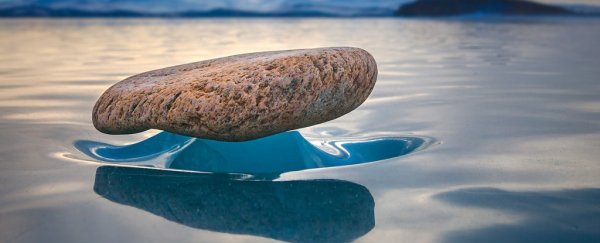On the frozen surface of Lake Baikal in Siberia, nature makes art.
There, on the frozen lake, stones can be found balancing atop narrow pedestals of ice in shallow cavities, as though carefully sculpted and placed. These are called 'Zen stones', and scientists have finally figured out how these formations occur – by reproducing the phenomenon in the lab.
The stone, physicists have found, acts as a sort of umbrella, shading just a small column of ice from solar radiation, and preventing it from sublimating, resulting in a thin structure of ice supporting the stone.
Moreover, far-infrared black-body irradiance of the stone itself creates the shallow depression around the base of the pillar.
"Zen stones are fascinating natural structures consisting of a stone standing on a slender ice pedestal, whose origin had long been misunderstood," physicists Nicolas Taberlet and Nicolas Plihon of the French National Centre for Scientific Research in France explain in their new study.
"We demonstrate that they are caused by a variation in the sublimation rate of the surrounding ice, which leads to the slow formation of a pedestal, adding to the very few reports of sublimation-driven pattern formation.
"Understanding this process sheds light on other differential ablation processes encountered on ice surfaces, such as debris-covered glaciers, whose existence is threatened by global warming, and icy bodies in space."
 Zen stones in nature, and the team's experiment. (Taberlet & Plihon, PNAS, 2021)
Zen stones in nature, and the team's experiment. (Taberlet & Plihon, PNAS, 2021)
Zen stones look incredibly beautiful, which has led to viral sharing, with image posts on popular websites attributing the phenomenon to wind erosion.
However, as Taberlet and Plihon note, these formations show no sign of the mechanical wear that would be associated with wind ablation; and Zen stones can even be found in caves, which affords some level of protection from the elements.
The researchers sought to explore the formation mechanisms of these ice pedestals by recreating the process in a vacuum chamber in a laboratory. A disk of aluminum representing the stone was placed on a block of ice, which then sublimated under infrared black-body radiation from the walls of the chamber.
In the absence of an aluminum disk, the ice sublimated isotropically (uniformly), mimicking the isotropy of diffuse sunlight on an overcast day. When the disk was placed on the ice, the researchers observed the formation of a pedestal, albeit at a deliberately accelerated rate – in nature, the formation process can take several weeks.
 A 'Zen stone' forming in the lab. (Taberlet & Plihon, PNAS, 2021)
A 'Zen stone' forming in the lab. (Taberlet & Plihon, PNAS, 2021)
Then, they employed numerical modeling to help them understand what was happening. This revealed that diffuse solar radiation sublimates the surface of the ice – that is, transforms it directly into vapor, bypassing the liquid stage.
However, the presence of the rock results in an uneven rate of sublimation. The rock acts as a sort of umbrella, leaving the thin column most protected from the radiation to sublimate last.
The cavity at the base of the column – conforming, the scientists noted, to the shape of the rock – was a little more perplexing. However, Taberlet and Plihon were able to show that these are shaped by far-infrared black-body radiation emitted by the stone itself, which emits in the temperature range of -20 to 0 degrees Celsius.
"While the umbrella effect is dominant regarding the overall dynamics of Zen stones, the far-infrared emitted by the stone is a necessary secondary effect, which creates the depression surrounding the pedestal," they write in their paper.
This, the researchers said, is very different from the formation of a very similarly shaped, but much larger natural structure – glacier tables. These form when direct sunlight melts the ice around a large rock, creating an object that looks a lot like a table.
"Glacier tables form because the rock may act as a thermal insulator, and therefore, their thermal properties (conductivity and specific heat) are crucial. The conclusion is exactly opposite for Zen stones as demonstrated by our experiments," the researchers explain.
"Moreover, since heat conduction within glacier tables is crucial, there exists a minimum thickness (which depends on the material) below which the stone sinks deep into the ice instead of forming a table. This regime cannot be observed in the conditions where Zen stones form, and even a very thin stone will lead to an ice pedestal."
The research has been published in PNAS.
